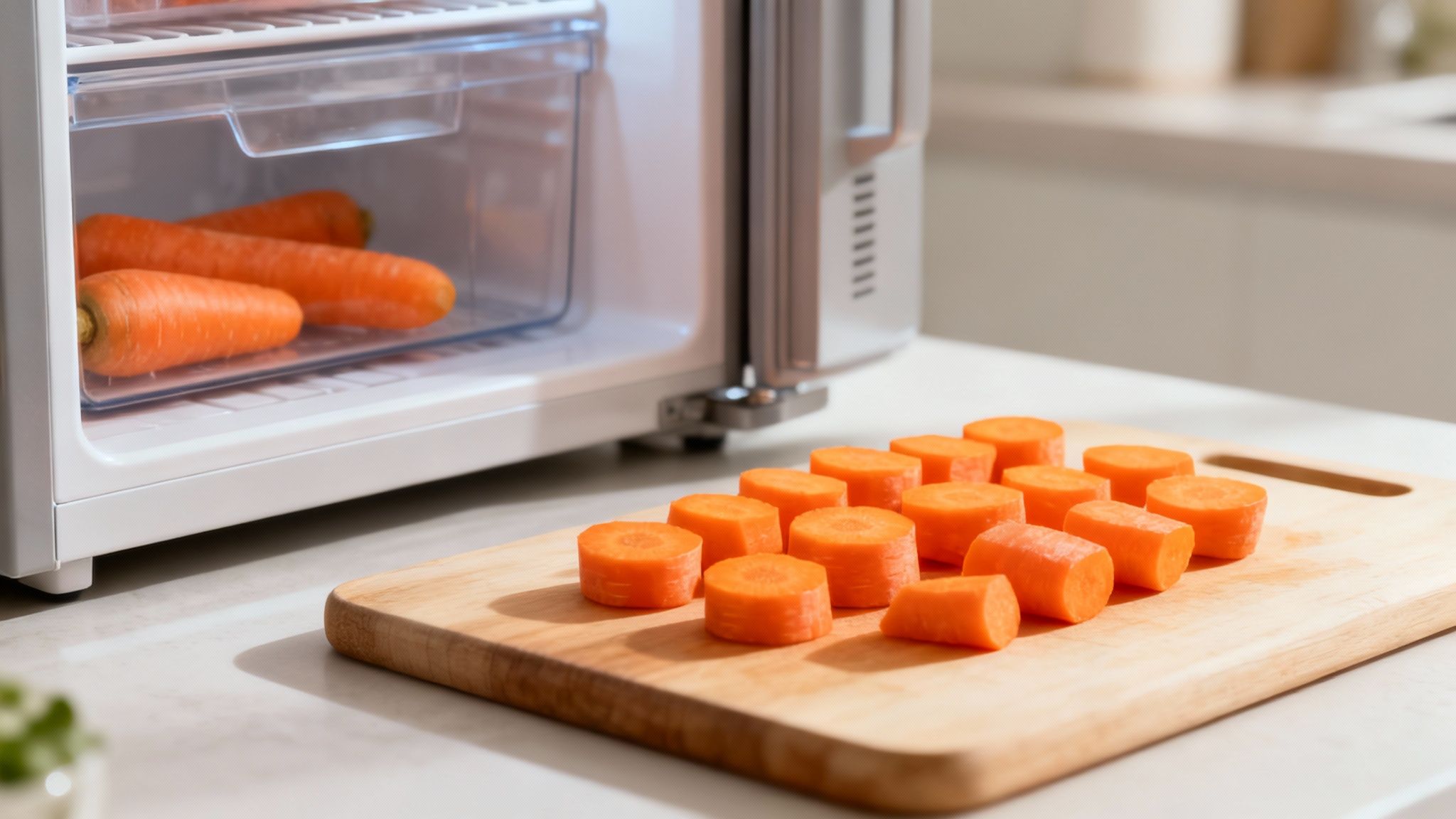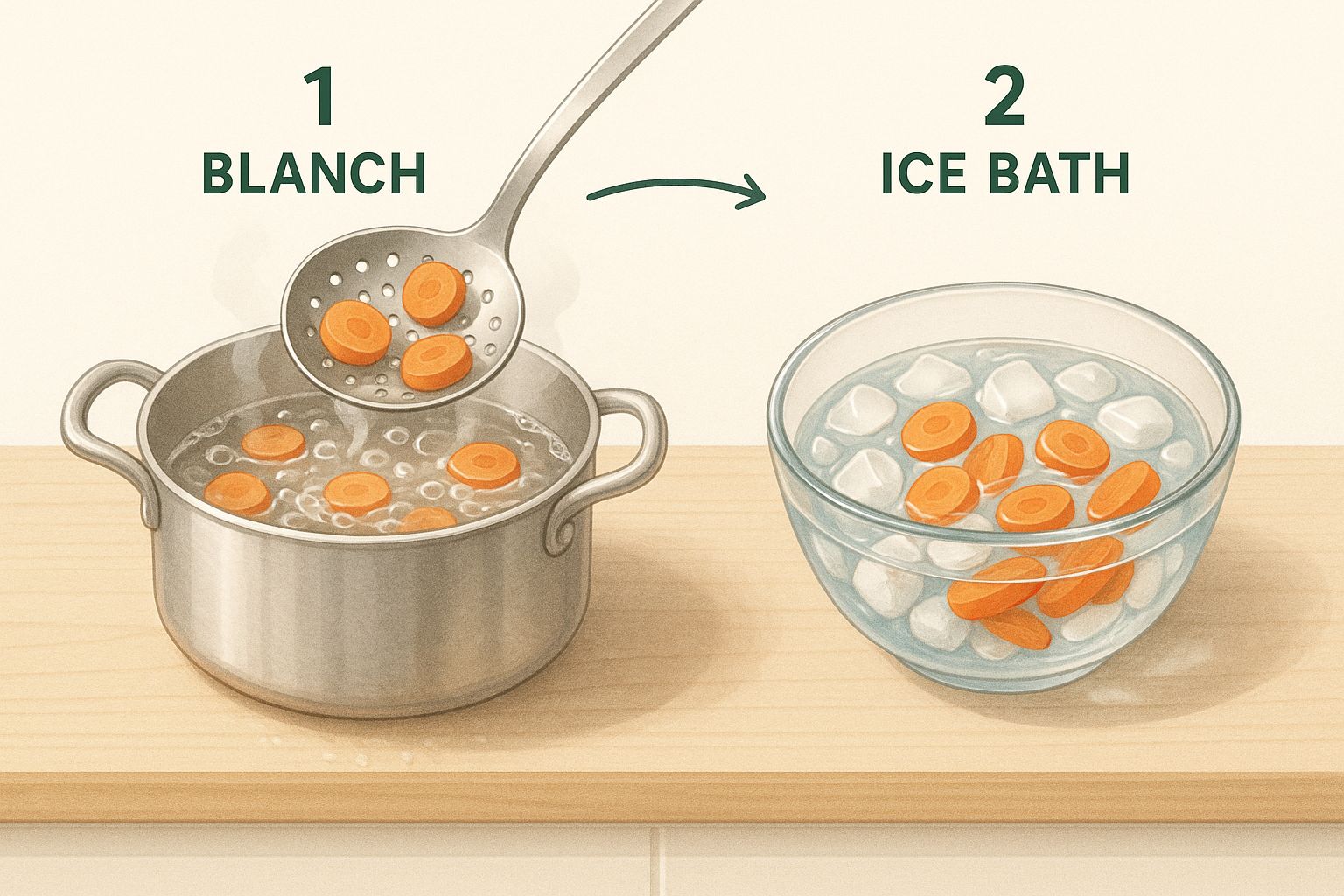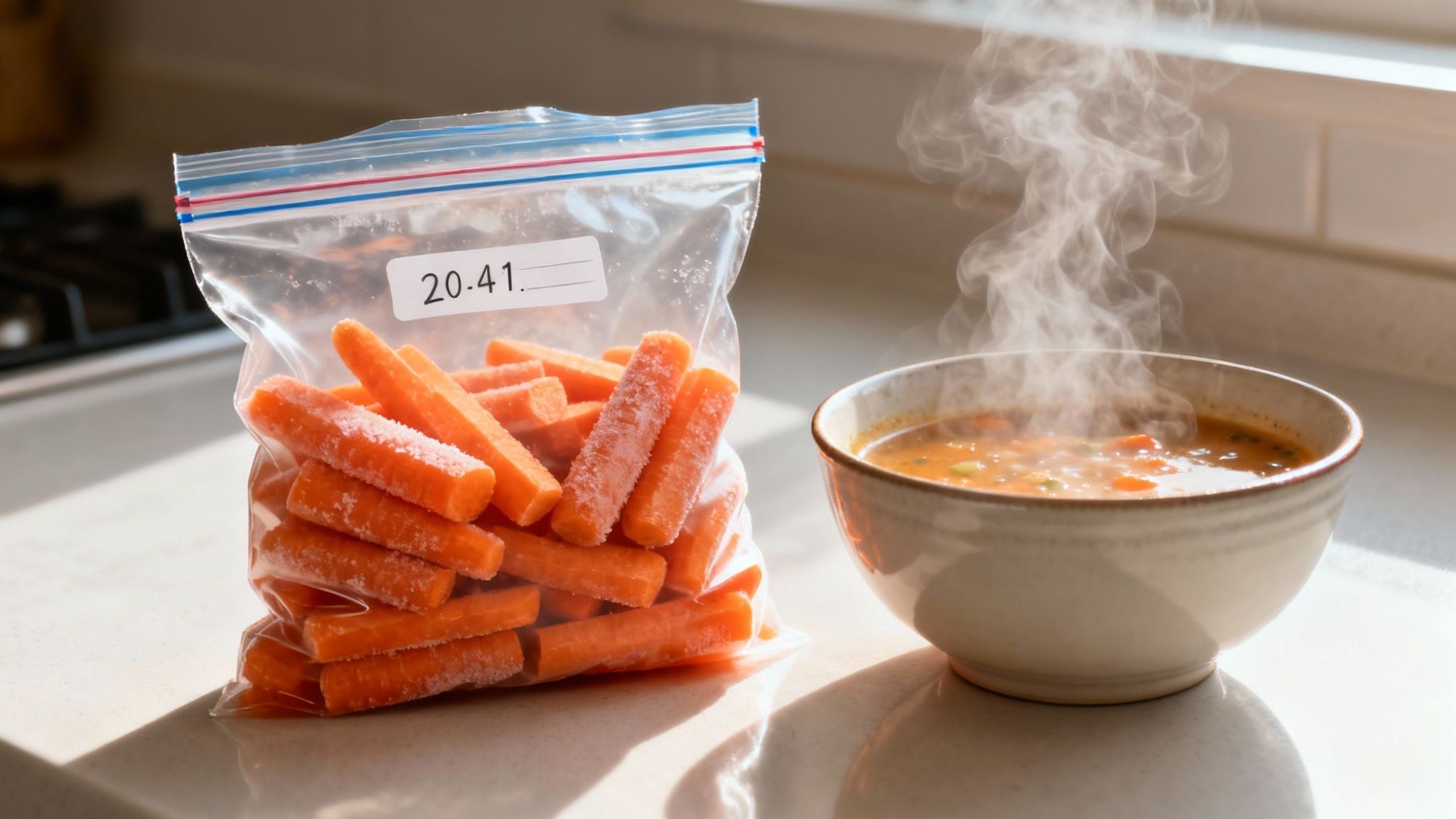Can Carrots Be Frozen? Your Ultimate Guide
Let’s get one thing straight right from the start: you can absolutely freeze carrots. In fact, it’s one of the smartest ways to keep this nutritious staple ready for future meals and drastically cut down on food waste in your kitchen.
Yes, You Can Freeze Carrots, and Here’s Why You Should
Freezing carrots isn’t just some kitchen hack; it’s a globally recognized preservation method that locks in their sweet flavor, vibrant color, and essential nutrients. It’s a simple skill that saves you money and guarantees you’ll always have a key ingredient on hand for a last-minute soup, hearty stew, or quick stir-fry. Say goodbye to finding those sad, limp carrots forgotten in the back of your crisper drawer.

There’s a common misconception that frozen vegetables are somehow less nutritious than fresh ones. But when you freeze them correctly, carrots retain a surprisingly high percentage of their vitamins. By mastering this technique, you’re joining a growing movement of savvy home cooks who value both convenience and nutrition.
The Real-World Benefits of Freezing Carrots
Thinking beyond simple storage, freezing your carrots offers several practical perks for any household:
- Slash Your Food Waste: It’s a fantastic way to handle a bumper crop from your garden or a great deal you found at the farmer’s market. Properly storing your produce is one of the most effective food waste reduction strategies you can adopt at home.
- Ultimate Convenience: Imagine having perfectly chopped, blanched carrots ready to toss into any dish. It’s a huge time-saver on busy weeknights when you need to get dinner on the table fast.
- Save Money: Buying carrots in bulk when they’re in season and preserving them for later is far more economical than purchasing them at a premium out of season.
This practice isn’t just a home-cooking trick; it’s big business. The global demand for healthy, convenient food has pushed the frozen carrot market to an estimated $2.5 billion as of 2025, and that number is only expected to grow.
For a quick overview, here’s a look at the key points of freezing carrots.
Freezing Carrots At A Glance
| Aspect | Key Takeaway |
|---|---|
| Nutrient Retention | Blanching before freezing helps lock in vitamins and minerals. |
| Flavor & Texture | Properly frozen carrots maintain a great flavor, ideal for cooked dishes. |
| Shelf Life | Can last 8-12 months in the freezer without significant quality loss. |
| Best Use Cases | Perfect for soups, stews, casseroles, and stir-fries. |
Ultimately, freezing is a simple and powerful tool for any home cook looking to make the most of their ingredients.
Freezing is just one of many ways to keep your harvest fresh. For a deeper dive, this extensive resource on how to preserve carrots for year-round freshness offers great insights into other methods like canning and drying.
Picking and Prepping Your Carrots for the Freezer
Let’s be honest, the secret to fantastic frozen carrots has nothing to do with your freezer. It all starts way before that—at the grocery store, the farmer’s market, or out in your own garden. Getting the best possible raw ingredients is the first step to a delicious final product.
You want to look for carrots that are firm, with a deep, vibrant orange color. Give them a quick squeeze. If they feel soft or rubbery, or you see a bunch of dark spots and cracks, leave them behind. The fresher the carrot, the better it’s going to hold onto its sweet flavor and crisp texture once it’s frozen.
Getting Down to Business: The Prep Work
Once you’ve got your beautiful carrots home, the prep work is simple but super important. First things first, give them a good scrub under cool running water to get rid of any dirt. Even if you’re peeling them, you don’t want to be dragging that grit across the carrot with your peeler.
Speaking of peeling, while the skin is technically edible, it can get a little tough and bitter after freezing. For the best texture and flavor, I always recommend peeling. A standard vegetable peeler is all you need to get a clean, smooth surface that’s ready for chopping.
The real game-changer at this stage is consistency. Cutting your carrots into uniform pieces is the only way to make sure they all blanch and cook at the same rate. This simple step saves you from that frustrating mix of mushy and undercooked bits later on.
Whether you’re going for coins, dice, or little sticks (julienne), just try to keep the pieces roughly the same size. Slicing them into coins about ¼ to ½ inch thick is a great place to start. Nailing this uniformity is what will give you perfectly textured carrots every single time you raid the freezer for a quick dinner addition.
Mastering the Blanching Process
Blanching might sound like a fussy, technical step, but trust me, it’s the single most important thing you can do to make sure your frozen carrots are actually worth eating later.
Think of it as hitting the pause button. That quick dip in boiling water stops the natural enzymes in the carrots that would otherwise keep working in the freezer, slowly ruining their flavor, color, and texture. Skip this, and you’ll likely end up with carrots that are dull, rubbery, and just taste off.
Taking a few extra minutes to blanch is the difference between a disappointing side dish and a delicious, convenient meal addition. It guarantees that the bright, sweet carrots you packed away are the same ones you pull out months later.
This infographic breaks down the simple two-stage process, from the boiling water bath to that crucial ice shock.

As you can see, the key is moving the carrots from hot to cold in a flash. That’s what locks in their crisp texture.
Executing the Perfect Blanch
First, get a large pot of water to a rolling boil. You don’t need to add any salt. While that’s heating up, prepare a big bowl of ice water—this is for the “shock” that instantly stops the cooking process right in its tracks. You want it ready and waiting the second your carrots are done boiling.
Once the water is bubbling, carefully drop in your prepped carrot pieces. Timing here is everything, and it really depends on how you cut them:
- Sliced Coins or Diced Pieces: Boil for 2 minutes.
- Whole Baby Carrots or Sticks: Boil for 3 minutes.
Set a timer! Even an extra minute can lead to mushy carrots. As soon as the timer goes off, use a slotted spoon or a spider strainer to quickly fish the carrots out of the boiling water and plunge them directly into the ice bath. This is the same technique we use for other vegetables, like in our guide on how to freeze fresh zucchini.
Let the carrots hang out in the ice water for the same amount of time they were boiled. This ensures they are completely cooled down and the cooking has fully stopped.
This method of quick-cooking and freezing, known commercially as Individual Quick Freezing (IQF), is the secret to maintaining high-quality frozen produce. It’s so effective that it’s a cornerstone of the global food service industry.
The growing demand for premium frozen vegetables really speaks to how well preservation techniques like blanching work. In fact, you can see how advancements in this space have helped the global IQF carrot market grow by checking out these market insights on Market Report Analytics.
After their ice bath, drain the carrots thoroughly. The final, critical step is to pat them completely dry with a clean kitchen towel before you move on to freezing.
Choosing Your Freezing Method
You’ve done all the hard work, and now your carrots are just one step away from their long winter’s nap in the freezer. You’ve got two main ways to go here, and your choice really boils down to convenience now versus convenience later.
The quick-and-dirty method is to simply pack your blanched, dried carrots straight into freezer bags. It’s fast, simple, and gets the job done. The downside? You’ll almost always end up with a solid, icy block of carrots, forcing you to thaw the whole bag or try to chisel off a few pieces when a recipe only calls for a handful.
The Flash Freeze Advantage
This brings us to the second, and in my experience, far better method: flash freezing. This little trick is an absolute game-changer for anyone who freezes produce at home. It’s exactly what it sounds like—a quick freeze to lock in the quality of each individual piece.
Here’s how it works:
- Spread your blanched and dried carrot pieces in a single layer on a baking sheet. I always line mine with parchment paper to prevent any sticking.
- Make sure none of the pieces are touching each other! This is the key to keeping them separate.
- Pop the whole tray into the freezer for 1-2 hours, just until the carrots are frozen solid to the touch.
Once they’re individually frozen, you can tumble them into your freezer bags or containers. Now, every piece is separate, ready to be scooped out as needed.
This small investment of time upfront pays off every single time you cook. When you can just open a bag and pour out the exact amount of carrots you need for a soup or stir-fry, you’ll be so glad you didn’t skip this step.
This home technique actually mimics the commercial Individual Quick Freezing (IQF) process that has become a cornerstone of the modern food industry. The convenience of IQF is a major reason the global frozen vegetable market hit USD 53.85 billion in 2024. As our lives get busier, the demand for nutritious, easy-to-use food is only growing. You can read more about these industry trends over at GlobeNewswire. By flash freezing, you’re bringing a professional preservation technique right into your own kitchen.
How to Store and Use Your Frozen Carrots
You’ve done the hard work of blanching and freezing your carrots. Great job! Now comes the final, crucial step: storing them properly. This is what stands between you and disappointing, flavorless carrots down the road.
The number one enemy of frozen food is air. Your goal is simple: get as much of it out of the bag as you can.

Vacuum-sealed bags are the undisputed champion here. They pull out nearly all the air, keeping your carrots tasting incredibly fresh for months. But don’t worry if you don’t have a vacuum sealer—standard zip-top freezer bags work just fine. You just have to be diligent about pressing out every last bit of air before you zip it up.
Trust me on this one: label every single bag. Grab a permanent marker and write the date on there. You’d be surprised how quickly things get lost in the freezer abyss. A simple date ensures you’re always using the oldest batch first.
Cooking with Your Frozen Carrots
This is where all your prep pays off. The absolute best part about having a stash of frozen carrots is how unbelievably convenient they are. For almost every recipe, you can skip the thawing step entirely.
Seriously, just toss them straight from the freezer into whatever you’re cooking. This is a huge time-saver and, believe it or not, gives you a much better final product.
They are perfect for:
- Soups and Stews: They’ll thaw and cook right in the broth, infusing it with their sweet flavor.
- Roasts: Throw them in the pan around a chicken or pot roast during the last hour of cooking. Easiest side dish ever.
- Stir-fries and Casseroles: They cook up fast and keep a pleasant, firm-tender bite.
Thawing carrots first often makes them watery and mushy. The only time you might even consider a quick thaw is if a recipe calls for very precise, even cooking times alongside other fresh veggies. Otherwise, freezer-to-pot is the way to go.
Keeping your freezer at a stable, low temperature is what locks in that quality. This is a core concept in food preservation. If you’re curious about the science behind it, learning about the principles of cold chain management can offer some fascinating insights into keeping all your frozen foods safe and delicious.
Common Questions About Freezing Carrots
Even with a step-by-step guide, it’s natural to have a few questions pop up, especially when you’re trying a preservation method for the first time. I’ve gathered the most common queries I hear to give you clear, straightforward answers. This way, you can freeze your carrots with total confidence.
Can You Freeze Carrots Without Blanching First?
Technically, you can, but I really, really advise against it. Freezing raw carrots almost always leads to a disappointing result.
Without that quick dip in boiling water, enzymes continue to break the carrot down even in the freezer. The outcome? A rubbery texture, dull color, and a noticeably “off” flavor once they thaw. Think of that quick blanch as your insurance policy for quality.
How Long Do Frozen Carrots Last?
When you follow the right steps for blanching and storage, your frozen carrots will maintain excellent quality for 10 to 12 months in a freezer set to 0°F (-18°C).
They’re still perfectly safe to eat after that point, but you might begin to notice a gradual decline in their texture and flavor.
The real magic of stocking a freezer is the convenience it brings to meal planning. Once you realize you can preserve one item, like carrots, it opens the door to freezing entire meals. For instance, many people wonder about comfort food classics, and our guide on whether you can freeze baked macaroni and cheese explores that very topic.
What Is the Best Way to Cook with Frozen Carrots?
For just about any cooked dish—soups, roasts, casseroles, or stir-fries—add the carrots directly from the freezer. Don’t thaw them first!
They cook up quickly and will retain a much better texture this way. Thawing them beforehand often makes them release too much water, which can lead to a mushy consistency in your final dish. Just keep in mind, they aren’t suitable for raw preparations like salads.
Ready to elevate your meals without the daily prep? Culinary Collective Atl offers personalized private chef services to bring delicious, handcrafted dishes right to your table. Learn more about our custom meal plans at https://www.theculinarycollectiveatl.com.





